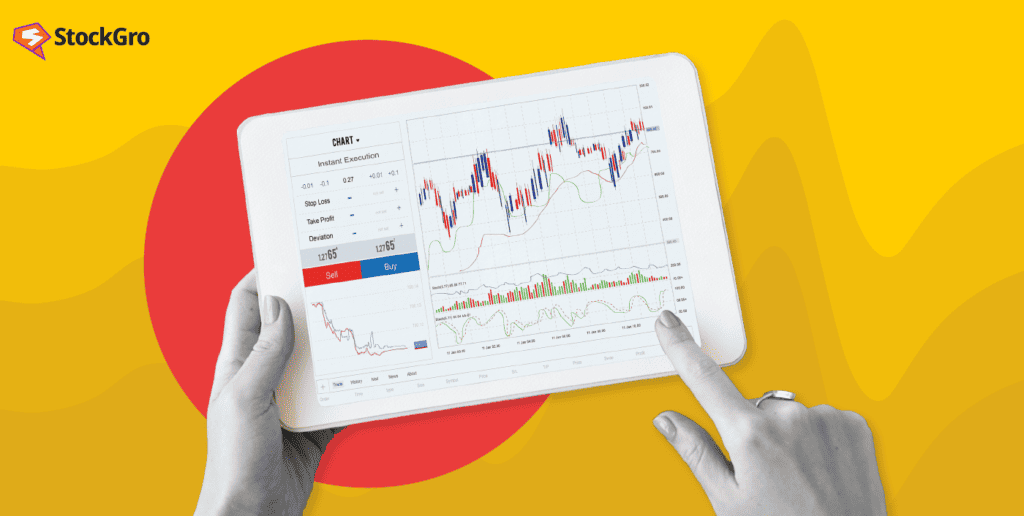
When trading or investing in the stocks of newly listed companies, most of us might second-guess ourselves. We might wonder if the company is in good hands, if they’re making profits, and whether they have it in them to stick around for the long term.
Luckily, all this information is publicly available to every investor if they know where to look.
The process of figuring out the intrinsic value of a company by evaluating important metrics like its financial health, performance, and overall prospects is called fundamental analysis. Now, there’s no one right way to analyse a company.
Professional investors use a wide range of tools, loads of data, and hundreds of sources to verify their information – and still manage to be right only about 60% of the time.
But one metric that every professional investor uses, directly or indirectly, is the P/E ratio, which is what we’re going to get into today.
You may also like: Everything you need to know about stock market portfolios
What is the P/E ratio?
The P/E ratio is an acronym for a company’s Price to Earnings. This is a simple tool used to understand investors’ confidence about the company’s future growth. It calculates how much investors are willing to pay for a company’s earnings.
How P/E in the stock market is calculated?
To calculate the P/E ratio, we need two metrics: the company’s current stock price and the earnings per share (EPS). We attain the ratio by dividing the current price by the EPS.
For example, if a company’s stock is trading at ₹1,000 per share and its earnings per share comes to around ₹40, the P/E ratio would be 25 (1000/40). This ratio tells us that investors are willing to pay 25 times the company’s earnings to own a share of the stock.
Formula: P/E Ratio = Stock Price / Earnings per Share (EPS).
Note: Both the stock price and EPS for publicly-traded companies are readily available from financial reports on the internet.
What is a high P/E ratio?
A high P/E generally means that investors are willing to pay a premium for each rupee of earnings – meaning that the market expects the company to be profitable in the future. This outlook is justified if the company experiences strong earnings growth in previous quarters or has a promising outlook in general.
However, sometimes, this could also mean that the stock is overvalued. There could also be a risk of a price correction if the company fails to meet market expectations or if bad news hits the media.
Also Read: The ABCs of stock market: Consolidation and Breakouts
What is a low P/E ratio?
A low P/E means that the stock is trading at a lower price relative to its earnings per share – suggesting that the market has low expectations for the company’s future prospects or that the stock is undervalued.
A low P/E ratio could also be a signal for value investors who could strike a bargain by buying at the current price. On the other hand, the market wouldn’t pay a premium for the stock because of underlying issues or financial difficulties.
Types of P/E ratios
Here are some modified versions of the above P/E ratio that investors use to extract even more information about the company.
Forward P/E — As the name suggests, this metric uses the company’s estimated future earnings per share to calculate the ratio instead of the regular EPS. Projected earnings for the next fiscal year (or several years) are used to determine this ratio.
Forward P/E provides a glimpse into market expectations for future earnings’ performance. This is very helpful when companies undergo changes in their earnings trajectory when making significant business transformations.
Trailing P/E — On the other hand, the trailing P/E ratio is based on historical earnings data from the past four quarters (prvious financial year). It is commonly used to assess the company’s current valuation based on its recent financial performance.
Hence, while the forward P/E relies on estimated future earnings, the trailing P/E utilises historical earnings. As a result, the forward ratio is forward-looking and provides insight into future expectations, while the trailing ratio is backward-looking and reflects past performance — both of which are equally important in fundamental analysis.
Factors affecting P/E ratios
There are more factors that affect the P/E rather than just the two variables involved in the formula.
- Market sentiment — When investors are optimistic about a company’s future, they tend to drive prices up, which eventually affects the P/E too. Positive news, product launches, successful acquisitions, and innovative developments can all boost sentiments and result in a misrepresented ratio.
- Industry trends — Certain sectors or industries may also be perceived as more attractive to investors due to favourable long-term growth prospects. For instance, battery companies might expect an elevated P/E in the short and long-term when subsidies are announced on electric car sales. Some ratios may also work cyclically, waxing and waning throughout the year.
- The broader economic picture — During economic downturns or recessions, overall market sentiment tends to turn cautious, leading to lower P/E ratios across various sectors. The opposite might be true during bull runs.
Effectiveness as a metric
Fundamental analysis, as a science, has to be performed with an extensive knowledge of how companies function. Using one metric in isolation, even one that’s very effective like the P/E ratio, is not advisable. Every metric has its limitations, and here are some that apply to this one.
One of the most significant limitations is that the P/E doesn’t consider extraordinary events or one-time factors that can significantly impact a company’s earnings. For instance, a company might experience an unexpected price dip from the sale of assets or a legal settlement, resulting in a temporary boost in earnings.
Conversely, a company could log substantial losses due to a natural disaster. These events can easily distort the P/E, making it less accurate.
Secondly, the P/E ratio could be misleading due to different accounting standards. Some companies may adopt aggressive accounting methods to inflate earnings artificially, while others may be conservative in their approach, leading to understated earnings. These discrepancies could, again, mislead investors.
Conclusion
As we said, the P/E ratio is one of the most popular fundamental metrics used for stock analysis by investors around the world. However, one metric doesn’t always give you the whole picture. It is always wise to use the P/E ratio in conjunction with other metrics so you can gauge whether it represents reality or has been artificially inflated or deflated.
FAQ’s
1. What is a good PE ratio?
A PE ratio between 10 and 25 is generally considered good, depending on the industry. A higher PE may indicate strong growth expectations, while a lower PE might suggest undervaluation or challenges.
2. What does a PE ratio tell you?
The PE ratio shows how much investors are willing to pay for each dollar of earnings. It helps assess whether a stock is overvalued or undervalued, with a high PE indicating growth expectations and a low PE potentially signaling undervaluation.
3. Is a higher PB ratio better?
A higher PB ratio suggests investors are willing to pay a premium for future growth, but it doesn’t always mean it’s better. A very high PB ratio can indicate overvaluation, so it should be compared with industry peers.
4. What does a PE ratio of 30 mean?
A PE ratio of 30 means investors are paying 30 times the company’s earnings. It usually indicates high growth expectations, especially in growth sectors like tech. However, it may also suggest overvaluation if compared to industry norms.

